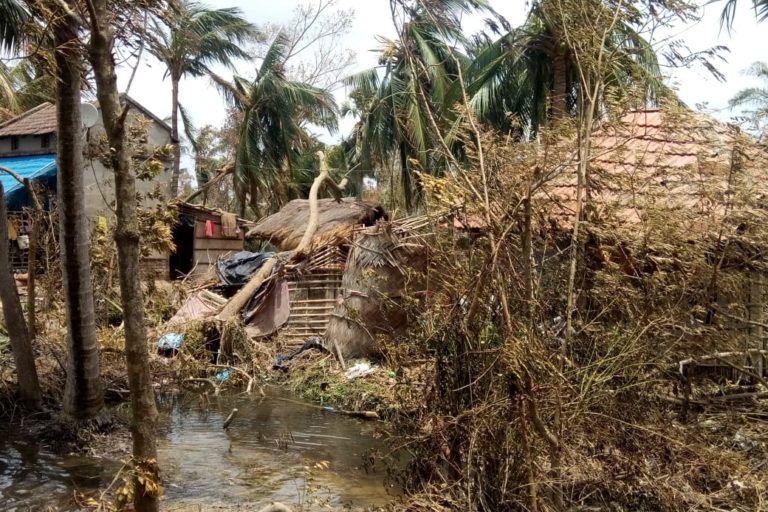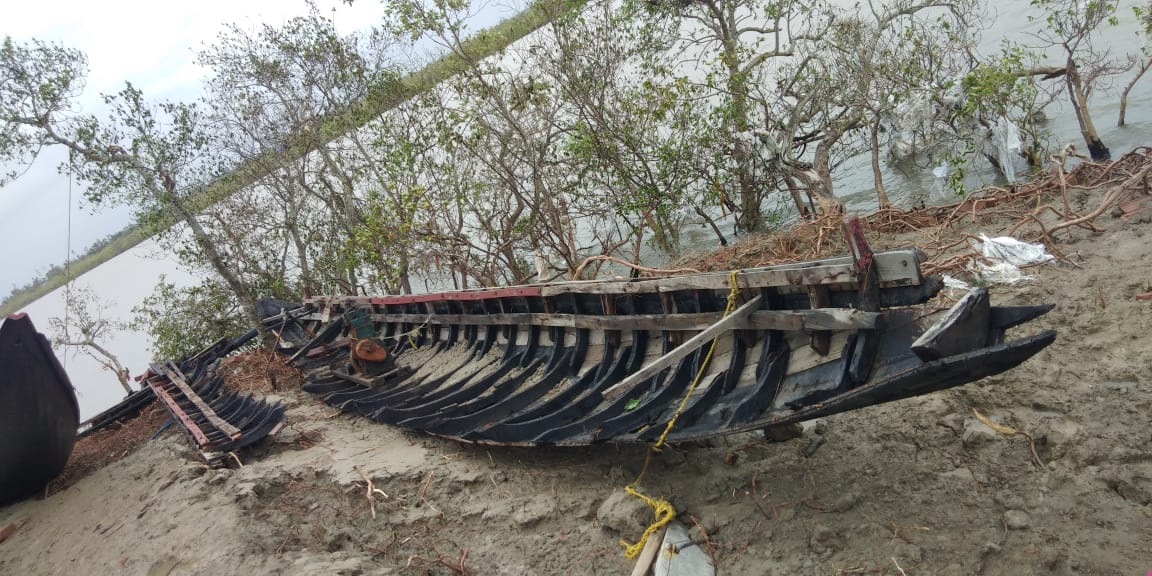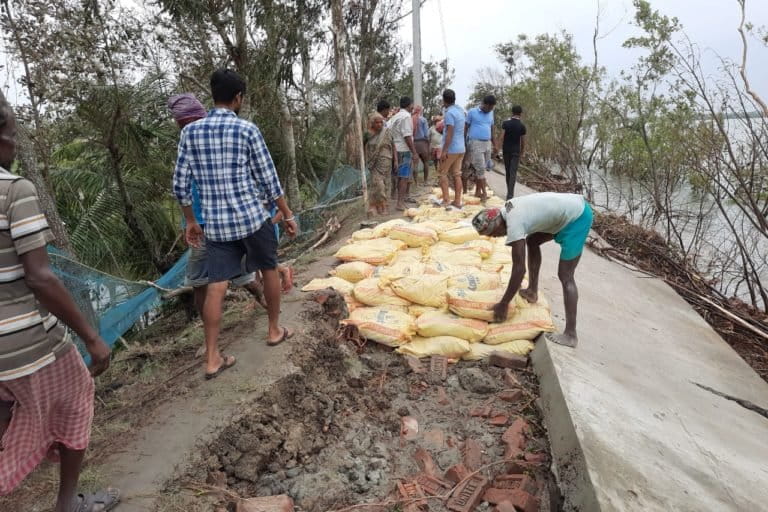- Extremely severe cyclonic storm Amphan has severely impacted the Sundarbans island communities in West Bengal who were reeling from the effects of the coronavirus disease associated lockdown that had dealt a blow to livelihoods.
- Amphan is considered even more destructive than cyclone Aila, which slammed the region in May 2009.
- With standing crops destroyed and salt water ingress cutting off chances of agriculture for the next two years, Amphan may trigger a fresh wave of migration even as the state authorities have assured creation of jobs in the islands.
Madan Mondal, who was employed in the textile sector in south India, was relieved to be back home in the Sundarbans in coastal West Bengal just days before India announced the national lockdown in March 2020, to contain the novel coronavirus disease (COVID-19) pandemic.
Despite an uncertain future on account of the COVID-19 pandemic related lockdown, Madan was relieved to have been reunited with his aging parents. As lockdown restrictions began easing in May, he was planning to go back. But his respite was short-lived.
Amphan, an extremely severe cyclonic storm ravaged the islands, destroying homes, crops and livelihoods in the world’s largest mangrove forest as experts rue that lessons from cyclone Aila 11 years ago were clearly not learned.
Amphan barrelled into the Bay of Bengal amid a pandemic that mandates obligatory social distancing and hygiene guidelines to curb the disease spread. The cyclone triggered one of the biggest evacuation exercises in coastal Bengal at a time when most cyclone shelters (including school and office buildings) were already in use to quarantine returnee migrant workers for COVID-19 check.
Cyclone Amphan, which caused widespread damage around Kolkata is now considered even more destructive than cyclone Aila, which slammed the region in May 2009.
Amphan became the second supercyclonic storm over Bay of Bengal since the 1999 Odisha supercyclone. It crossed West Bengal–Bangladesh coasts between Digha (West Bengal) and Hatiya Islands (Bangladesh) close to the Sundarbans on May 20 with a wind speed of 155-165 kmph gusting to 185 kmph. It lashed coastal areas with brutal winds and rain, leaving at least 86 people across West Bengal in India and at least 10 in Bangladesh dead. It also displaced millions.
As the winds howled and sea breached the embankments on May 20th evening, Madan Mondal barely managed to persuade his elderly father to seek refuge in a cyclone shelter to save him from the storm.
“Permanent cyclone shelters and other safe places (school buildings) were crowded. The storm surge was as high as a two-story building. Our house, though still standing, is inundated with salt water. Many don’t have a home to go to. They are in tarpaulin tents. I have seen Aila, which was nothing in comparison to this,” said Madan over a patchy network as winds howled in the background.

‘Amphan is Aila’s granddaddy’
The Sundarbans forest spans the delta formed by the confluence of the Ganges, Brahmaputra and Meghna river systems. It is the largest continuous mangrove forest in the world. The 10,000 square kilometre region stretches along the coast of Bangladesh (where 60 percent of the forest lies) and India.
In the Indian Sundarbans 54 of the 102 islands support human settlements.
Communities in the Indian Sundarbans said the lockdown related to the pandemic was already influencing natural-resourced-based livelihoods such as agriculture and fishing that predominate in the Sundarbans, home to 4.5 million people.
Analyses of cyclonic events in the Bay of Bengal over a period of 120 years indicate a 26 percent rise in the frequency of high to very high intensity cyclones over this time period.
Aila caused enormous destruction to life and property along with coastal belts of West Bengal and Bangladesh. It was the strongest pre-monsoon cyclone in the past two decades (1989 to 2009) that had landfall in West Bengal.
Talking to Mongabay India, West Bengal Sundarbans Affairs Minister Manturam Pakhira termed Amphan as Aila’s “thakurda” (grandfather in Bangla) in terms of the ferocity and impacts. “Aila’s wind speed was 110, Bulbul was 130 but Amphan was 220 kmph,” he claimed.
Authorities have begun to assess the scale of damage on the ecosystem, infrastructure, and livelihoods. Paddy fields have turned barren due to the saltwater ingress. Pond water is salty. Relief in the form of dry food items, tarpaulin sheets for makeshift shelters/tents and bottled water has started coming into the islands as communities struggle for potable water.

Areas such as Ramganga in Patharpratima community development block are completely inundated. Roughly about 2-2.5 km of embankment breached on the afternoon of 20th May itself, Sudhangshu Maity, a resident of Ramganga, told researchers associated with GCRF Living Deltas Research Hub, an interdisciplinary research hub on the Red River, Mekong, and the Ganges-Brahmaputra-Meghna.
“Dead fish and debris are floating in the water and the delta communities there are living amidst the stench. Uprooted trees are also blocking everything. The locals have now taken it upon themselves to remove the trees and collect the debris. But they don’t know where to dump/ bury the fish since it is flooded everywhere,” the Hub’s researchers told Mongabay-India in an email.
“The delta people have access to a tube well which is also used for personal sanitation purposes. They are afraid to eat (from their stock of dry food) because then they will need to use the toilet which is a challenge now with lack of water and inundation everywhere. The embankment cannot be repaired now because of the approaching monsoon. So for another few months, they will have to bear the regular inundation from the tides.”
Madan who like others in his community had moved out of the Bay of Bengal region to pick up work elsewhere after Aila’s devastation says many more will venture out of the islands and look for better income options this time if state authorities do not create sustainable jobs for them.
“We had begun to recover from Aila but Amphan has set us back again by years. There is no scope for agriculture for at least two to three years. I will go back to Karnataka where I work in the textile sector as soon as the situation stabilises a bit. I have heard from my employers that they are restarting work.”
Due to paucity of fresh groundwater resources, mono-cropping is common, which exposes them more to climate hazards such as floods and cyclones. For many, migration is a way out. In the Indian Sundarbans Delta, where sea levels are rising, one in five households has at least one family member who has migrated, according to a research survey.
Livelihood loss may trigger fresh wave of migration
SK Sarangi for ICAR-Central Soil Salinity Research Institute, India said the cyclone’s untrammeled fury has destroyed all standing crops and it would take at least two years to start some form of cultivation due to the saline ingress into agricultural fields. He too said there is a possibility of a fresh wave of outmigration.
“Cyclone Amphan’s impacts on the communities will be stronger than Aila. This is because a larger area has been affected by saltwater intrusion. Trees and standing crops were destroyed, livestock dead, livelihoods affected and infrastructure such as irrigation etc. has been hit hard,” said Sarangi.
Sarangi estimates that as much as 50 percent of the area under agriculture will decrease due to a combination of saltwater intrusion into the fields and cyclone-driven loss of land. Cultivation of pulses will be set back by at least five years.
Sarangi said monsoon rains have to be utilised judiciously to flush out the salt from the fields.
“Salt tolerant rice varieties (both indigenous and high yielding ones) will have to be distributed in huge numbers to enable paddy cultivation. The communities had started recovering from Aila and for the last two to three years they were gaining from cultivation of pulses. Whatever they gained, they lost it all in Amphan,” added Sarangi.
The COVID-19 had already impacted riverine fishing, honey collection, crab collection, and tourism. Cyclone Bulbul in November 2019 had flattened crops.

Tuhin Ghosh of Jadavpur University’s School of Oceanographic Studies, who has mapped migration in the Indian Sundarbans Delta adds that a fresh wave of migration post-Amphan is likely.
“Those who had returned will go back to the places where they worked before the lockdown or look for new jobs. Then you have those who will be forced to move out in search of opportunities because of the long-term impacts of Amphan on livelihoods,” said Ghosh.
However, Manturam Pakhira assures that the state government has taken a decision to generate jobs, incorporating post-cyclone rebuilding work, under the employment guarantee scheme. “We will ensure they have livelihoods.”
A section of experts has been advocating a planned or managed retreat strategy for the Indian side of Sundarbans. They envisage a planned retreat from the vulnerable to stable zones in the Sundarbans, but with the simultaneous regeneration of mangroves in the vacated region.
Amphan has undermined the communities’ confidence, said Sanjoy Mondal, a tour operator who owns four boats, one of which was pummeled by the storm into bits. Sanjoy believes people will stay and look out for one another, they will manage to cling onto any form of livelihood they find, for the time being.
“We, the people of Sundarbans, take cyclones and other environmental challenges in our stride and we have learnt to live with them. When COVID-19 came we thought we would somehow get over it with the little that we have. But Amphan has shaken our confidence,” said Sanjoy, whose ancestral home is in Kumirmari in the Sundarbans.
He said the brutal winds had destroyed the basic infrastructure of a freshwater project that he and other members of the community used to run to provide potable water to the residents, especially to honey collectors and tour boat operators. “At least in Bulbul and other instances we could get together and provide fresh water to our people but this time we could not offer that service,” Sanjoy lamented.
Minister Manturam Pakhira said there is no single islander who can claim that they did not see any form of damage.
Vigil over human-tiger interactions
One of the key concerns is repairing damages and reinforcing the girdle of 105 km of nylon net fencing in the Sundarbans Tiger Reserve that prevents human-tiger interactions. The Indian Sundarbans is home to 96 royal Bengal tigers according to the latest census.
The forest department, which anticipated and prepared its staff for animal injuries and increased human-wildlife interactions in the aftermath of the cyclone, is working on addressing these concerns.
“Animals such as crocodiles and snakes are swept inside villages when water from the storm surge inundates the villages. Cyclone Fani in 2019 brought the red-tailed tropicbird, a seabird, into West Bengal. We are also addressing the animal injuries that are common due to trees being uprooted,” G. Santhosha, Divisional Forest Officer (DFO) of South 24 Paraganas Forest Division, West Bengal, told Mongabay-India, adding that the entire length of 52 km of nylon net fencing has been ripped off in the division and entire 1660 square km of the forest has been destroyed in that area.
Pradeep Vyas, former principal chief conservator of forests and wildlife, West Bengal, emphasised that a prey base estimation (such as for wild boars) must be carried out immediately after the cyclone to ascertain if tigers can sustain on the prey base.
“After Aila, wild boar sightings had decreased. They could not survive the four to six hours of water inundation and it appeared that their carcasses were swept away into the Bay of Bengal. Due to prey base depreciation, there were increased incidences of tiger straying into villages,” Vyas said.
Accustomed to coping and living with environmental hazards including erosion, local communities, and grassroots organisations have already begun to patch up the cracked stretches of embankments, informed mangrove ecosystem conservationist Anil Mistry.
‘Politics of embankment construction derailed protection’
Embankments are the only protection available to many people in the basin-like islands especially in the southern Sundarbans, added Mistry. The southern Sundarbans suffers from land loss due to erosion, there is frequent breaching of embankments with the related loss of houses and cultivable land.
According to the official record, out of the total girdle of about 3122 km lengths of embankment maintained by the Irrigation & Waterways Department, Aila damaged 778 km of the embankment. However, experts and local communities maintain the extent of the damage was much more.
To reconstruct the damaged embankment and dykes, the Ministry of Water Resources sanctioned Rs. 5032.00 crores to the state.

“The fund was never fully utilised. The state government did construct concrete structures but in a few stretches. Most of the mud embankments that exist today have foundations that go back to 150 years during the British colonial time,” said Sugata Hazra, professor and former director of the School of Oceanographic Studies at Jadavpur University, who has studied the area extensively.
Manturam Pakhira claimed that the then regime at the Centre, the United Progressive Alliance (UPA) led by the Indian National Congress, was disbursing the funds in phases and concrete structures were constructed in a few stretches. After the Narendra Modi-led Bharatiya Janata Party government came to power in India, the funds stopped coming.
“We have requested the Centre to release the remaining funds that were meant for post-Aila embankment reconstruction. We have to start everything from scratch.”
“But even if we rebuild everything, what guarantee is there that we will survive the next cyclone,” questioned Madan.
Andy Large, a field-based physical geographer with Newcastle University, and director of the GCRF Living Deltas Research Hub, said the initial urgent need is to repair breached embankments, as repeated inundation from the tides will destroy crops and magnify hardship to livelihoods. The other aspect that will affect immediate resilience is the oncoming monsoon where ameliorating effects like dilution of salinity will be undermined by the effects of flooding.
“The Hub will develop its research approach to examine the combined and synergistic impacts of cyclone Bulbul in November 2019 followed weeks later by the Covid-19 pandemic and now cyclone Amphan – the latter considered by some to have had the worst impact in the Sundarbans than Cyclone Aila in 2009.”
Banner image: People attempting to fix an embankment damaged after the cyclone. Photo by Sanjoy Mondal.
